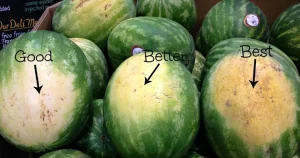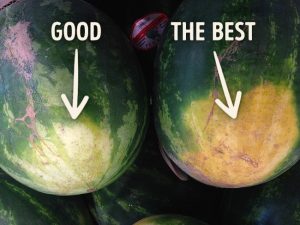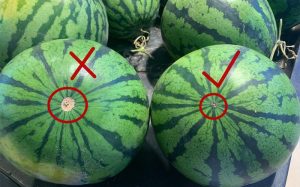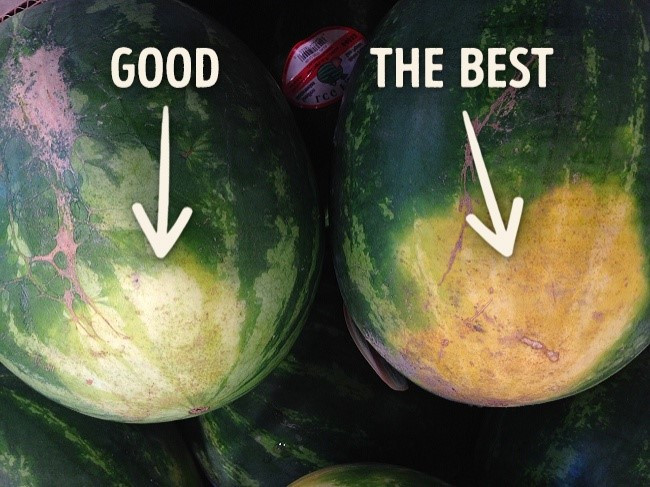When choosing watermelon to cool down in the hot season, remember to pay attention to this point, buy 10 and get 10 delicious and sweet fruits.
If you want to choose delicious watermelons this summer, remember to master these points, you don’t need to pat the fruit to choose delicious and sweet watermelons with thin skin.
Watermelon contains a lot of water and antioxidants, including lycopene, which can help protect the skin from the effects of UV rays and reduce the risk of sunburn. When the hot season comes, many people rush to buy watermelons to cool down. However, many women are not confident in their ability to choose watermelons. In fact, choosing to buy delicious and sweet watermelons is very easy, just remember the following tips, and you will be sure to buy “100% success”.

Tip 1: Look at the ground of the watermelon
A ripe, sweet watermelon will have a characteristic sign at the ground, this place often changes from butter yellow to dark yellow when the watermelon is ripe and juicy and ready to enjoy. If the yellow spots are large and clear, it means that the melon has ripened naturally on the tree and will have a sweet, juicy taste. This reflects the natural development of the watermelon under ideal environmental conditions, without being interfered with by unwanted growth stimulants.
In case you find that the underside of the watermelon is white, it is a sign that the melon has not had enough time to develop its natural sweetness. Unripe melons will often have a bland taste and substandard texture, along with a thick, difficult-to-cut rind. In some cases, unripe melons may have been harvested early and used a forced ripening method, sometimes requiring the use of stimulants to deceive consumers, reducing the quality of the melon.
In addition, brown spots appearing on the surface of the watermelon rind often make many people mistakenly believe that they are a sign that the fruit is no longer fresh and delicious. However, those brown spots are actually the result of a natural and very interesting process: Pollination by bees and insects. When the melon flower is well pollinated, it will develop into a high-quality melon with a higher natural sugar content – this is the source of the characteristic sweetness we enjoy.
The brown spots on the watermelon rind also reflect the level of pollination the plant has received during its development stage. A watermelon with many brown spots often indicates that it has undergone a full and repeated pollination process, which is one of the important factors behind the high sugar content and superior sweetness. This not only increases the nutritional value of the watermelon but also gives consumers a wonderful culinary experience with each sweet, cool piece of melon.

Therefore, when choosing a watermelon, do not hesitate before those that look imperfect with brown spots. They can contain a natural sweet flavor that you won’t want to miss.
Tip 2: Look at the shape
The shape of a watermelon is actually the result of the selection of a particular cultivar, reflecting genetic characteristics and the influence of the environmental conditions in which they grow. Some consumers often apply traditional tips to distinguish between “male” and “female” watermelons based on their round or elongated shape. However, it should be noted that with watermelon varieties that only produce elongated fruits, these tips are no longer suitable or accurate.
For the common watermelon varieties that we often see in the market, elongated watermelons are preferred by many people because they tend to contain more water. As for round watermelons, they tend to be sweeter. That does not mean that elongated watermelons are not sweet, but they tend to be more watery.
Tip 3: Look closely at the stripes
When a watermelon reaches its ripe and sweet state, it will be clearly shown through its external morphological characteristics. One of the most important indicators is the size of the stripes on the melon’s rind. For ripe melons, the stripes are not only large but also spread evenly across the rind, creating an easily recognizable sign.
On the other hand, if the melon is not of good quality, not properly ripened, or has not been properly cared for during its development, the stripes on the rind will often be smaller and less distinct. This is a warning sign that the melon may not have reached the sweetness you expect.
Tip 4: Observe the melon stem
One of the most important signs to pay attention to is the melon stem. Look for melons with stems that have withered and turned brown; this is a clear indicator that the melon is ripe enough to be sweet, soft, and ready to enjoy.
On the contrary, if you find the stem of the melon is still too green and large, consider before choosing because there is a high possibility that the melon is still young, the flesh inside may not have reached a bright red color, and the flavor may be a bit bland compared to a ripe melon.
A newly picked watermelon will still have a green stem, but after a few days of waiting, the melon will “dehydrate” – a term used to describe the process of the melon naturally losing water and the melon’s flesh becoming sweeter. At that time, the melon’s rind will thin a bit, the stem will begin to wilt, indicating that the flesh is sweet enough and full of water.
Tip 5: Look at the navel of the melon
When choosing a watermelon, carefully observing the navel of the fruit is a secret that not everyone knows. A watermelon with a large navel often shows that its rind is thicker, so the flesh inside not only contains many seeds but also may not reach the expected sweetness.

On the contrary, a small navel, but concave inside, is usually a sign of a watermelon with a thin rind. This watermelon is not only easy to cut and enjoy, but also has a flesh layer inside that contains fewer seeds. In addition, the water in the watermelon is distributed more effectively and concentrated, making each piece of watermelon juicy and sweet.
Tip 6: Choose a moderate weight
When choosing watermelon, consumers need to pay attention not to choose fruits that are too small or too large, because the quality of the fruit does not entirely depend on the size. A watermelon that is too light may not be ripe enough, while a watermelon that is too heavy may be overripe or have too much water. Therefore, the ideal weight for a delicious, sweet and nutritious watermelon is between 1.5 and 3kg.
This medium-weight watermelon is usually perfectly ripe, providing enough fiber, vitamins and minerals needed for the body without being too heavy, making it easy to transport. In addition, such a size is also suitable for the needs of most families, does not leave too much leftover food after each meal and retains the delicious flavor of the watermelon when stored in the refrigerator.
Tip 7: Tap on the watermelon
The method of checking the ripeness of a watermelon by tapping lightly on its skin is a method favored by many consumers. According to many years of experience passed down, a watermelon that has reached the right level of ripeness will have special sound characteristics when tapped. A clear and resonant sound is often a sign of a ripe, juicy watermelon. On the contrary, if the sound emitted when tapped is dull and short, it may indicate that the watermelon is still young and not yet fully ripe, meaning it needs more time to reach its best taste.
However, this tip often confuses many people. Therefore, just master the 6 tips above, a melon that has more of the above signs is a ripe, sweet and thin-skinned melon.
With these tips for choosing a watermelon that are easy to observe from the outside, wish you will be able to choose a delicious watermelon for yourself.


